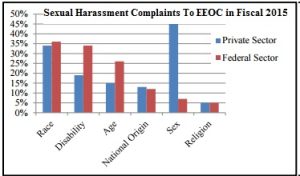Despite 30 years of training and sensitivity sessions since the U.S. Supreme Court first said sexual harassment is discrimination, workplace harassment has come to dominate the charges brought to the EEOC by private sector and state and government employees.
A report released today by the chairs of a task force of the Equal Employment Opportunity Commission declares that, “Too many people in too many workplaces find themselves in unacceptably harassing situations when they are simply trying to do their jobs.”
Of the approximately 90,000 charges of discrimination the EEOC received in fiscal year 2015, 28,000 — the largest share — alleged  sexual harassment in whole or among other charges. Counting only charges by workers in the private sector and those in local and state government, sexual harassment charges are includes in 45% of the complaints.
sexual harassment in whole or among other charges. Counting only charges by workers in the private sector and those in local and state government, sexual harassment charges are includes in 45% of the complaints.
And, says the report, most instances of sexual harassment never get reported. “Roughly three out of four individuals who experienced harassment never even talked to a supervisor, manager, or union representative about the harassing conduct.”
Written by two EEOC commissioners, the 88-page report lists six key findings and a seventh, a recommendation to launch an “It’s on Us” style campaign in workplaces across the country to raise awareness of the issue of sexual harassment.
Most significant for HR professionals is the finding that all the training of workers and managers has had little effect in reducing instances of on-the-job sexual harassment. The reason, says the report, is “it’s been too focused on simply avoiding legal liability.”
“Training is most effective when tailored to the specific workforce and workplace, and to different cohorts of employees,” says the report, though the authors caution, “It must be part of a holistic culture of non-harassment that starts at the top.”
Speaking Sunday, before the report’s release, EEOC Commissioner Victoria A. Lipnic, one of the report’s authors, admitted to an audience at SHRM’s 2016 Annual Conference & Exposition, that the finding about the ineffectiveness of training “was a jaw-dropping moment for us.”
“What we want people to understand is that if you are thinking training alone is a panacea to helping out any type of harassment, (it’s not). It doesn’t work,” Lipnic said.
Added Lipnic’s co-author and fellow commissioner, Chai Feldblum, “We’re trying to change behaviors.” “The best way to do that is to create a culture where it’s just not cool to sexually harass someone or racially harass someone.”
Two training alternatives are suggested in the report:
- Bystander intervention training, which gives co-workers tools to intervene when they witness harassing behavior.
- Civility training, which focuses on promoting respect and civility in the workplace.
If doing the right — and legal thing — is not enough motivation, the report notes that in the last fiscal year the EEOC recovered $164.5 million for workers alleging harassment. And that’s in addition to the mental toll it takes on victims. Beyond that are indirect costs from decreased productivity, increased turnover, and reputational harm.
